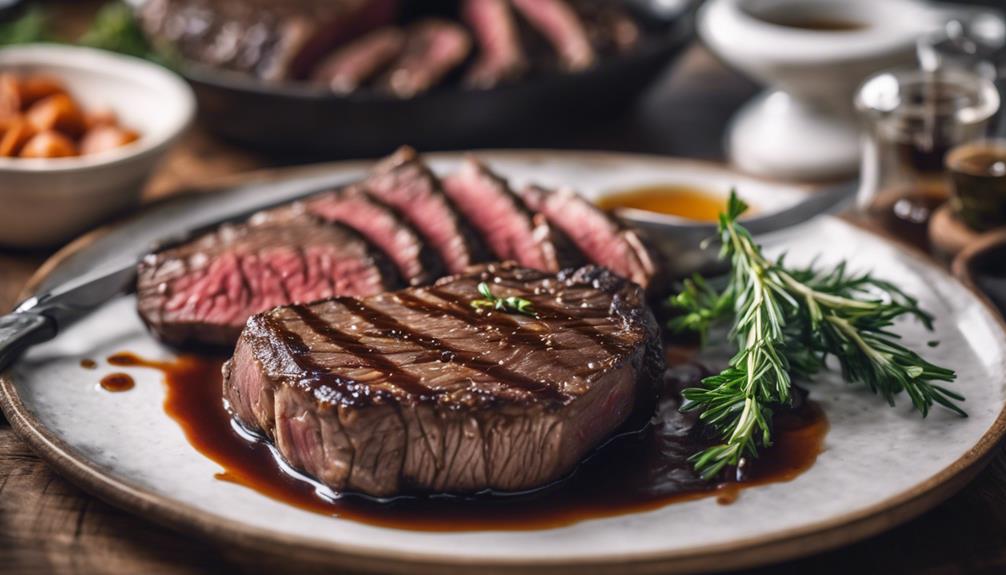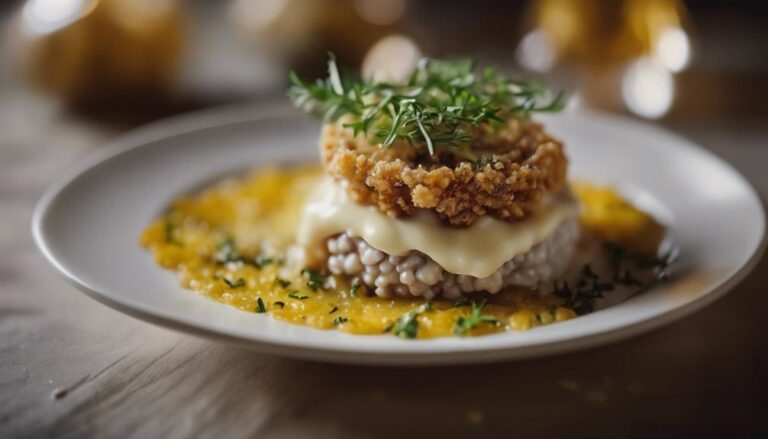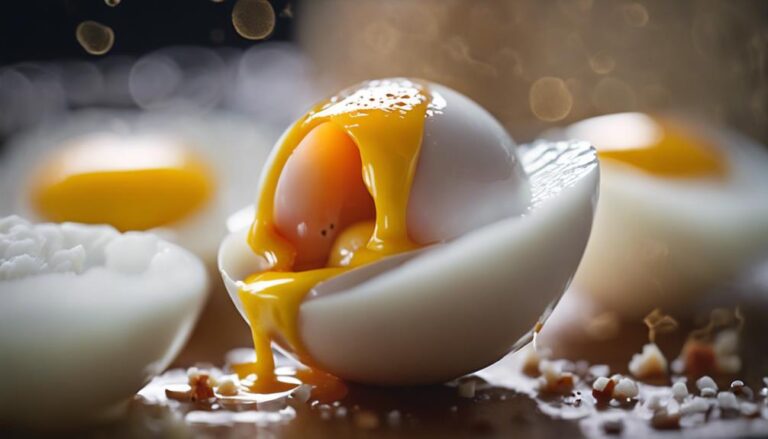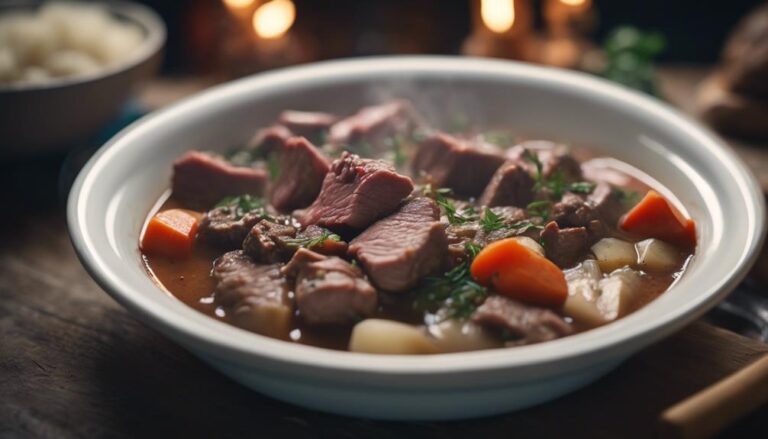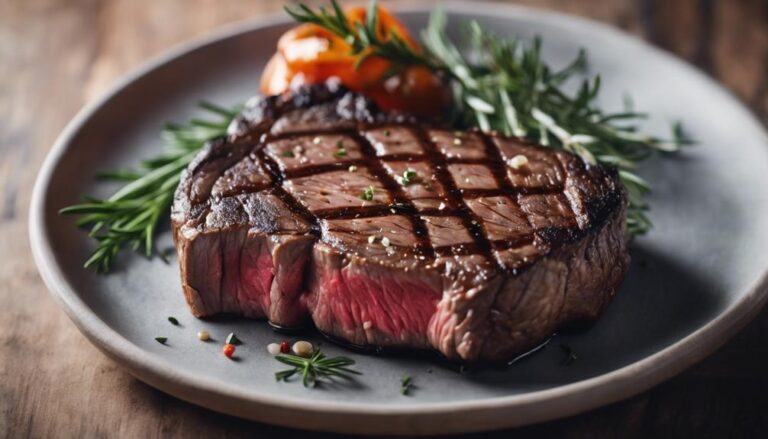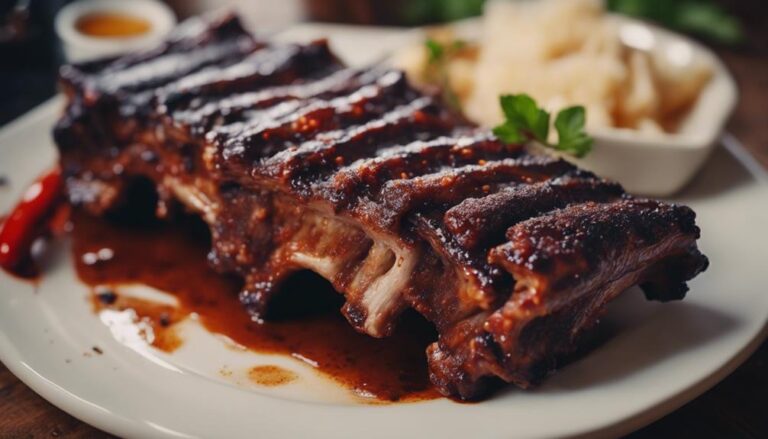Sous Vide Bison Steaks With Bone Broth Reduction
Perfect your culinary skills by preparing succulent sous vide bison steaks paired with a flavorful bone broth reduction. The precise sous vide method guarantees your bison steaks are tender and bursting with natural juices. Searing at high temperatures will give your steaks a caramelized crust while locking in all the exquisite flavors. The richness of bison meat combined with the depth of the bone broth reduction creates a delightful culinary masterpiece that is sure to impress your taste buds. Elevate your dining experience with this exceptional dish that showcases your cooking prowess. Master the art of sous vide bison steaks today!
What You Will Learn Here
- Sous vide cooking ensures unparalleled tenderness in bison steaks.
- Bone broth reduction enhances the rich and savory flavor profile.
- Culinary expertise shines through with perfectly executed sous vide technique.
- Searing bison steaks post-sous vide adds texture and caramelized finish.
- Overall experience promises exceptional taste, tenderness, and flavor depth.
Sous Vide Origins
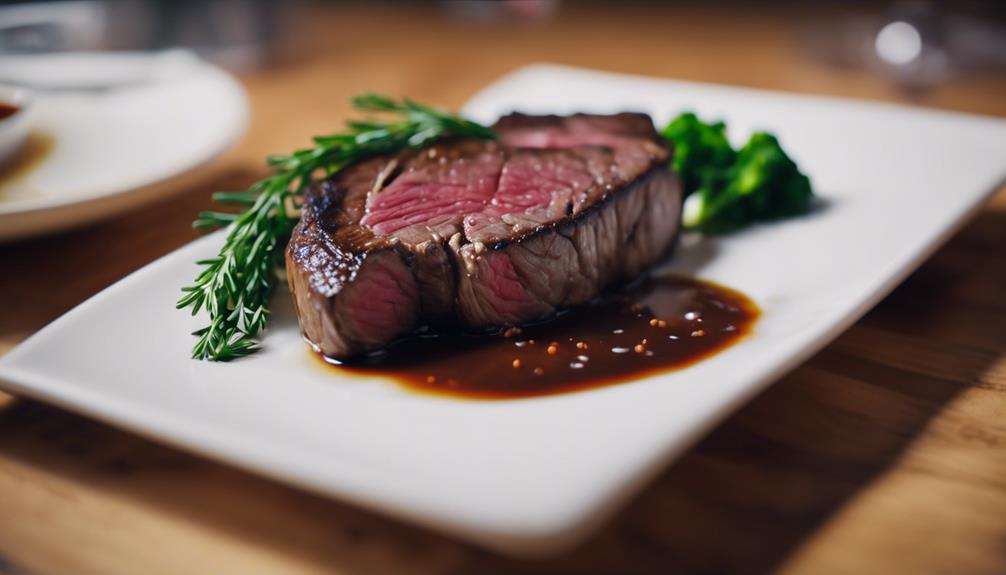
Sous vide cooking revolutionized traditional culinary methods by introducing precise temperature control, resulting in perfectly cooked dishes.
This technique's origin in high-end French restaurants showcases its pursuit of culinary excellence through innovation.
With the popularity of sous vide rising, home cooks now have access to equipment that promises restaurant-quality results in their own kitchens.
Sous Vide Cooking Method
Originating in France in the 1970s, the sous vide cooking method revolutionized culinary techniques by introducing a precise and innovative way to cook food in a vacuum-sealed bag at specific temperatures in a water bath.
This technique has been a game-changer, especially for proteins like bison steaks, ensuring they're cooked to perfection every time. By cooking food slowly and evenly in a controlled water bath, sous vide helps retain the natural flavors and juices of the ingredients, resulting in succulent and tender outcomes.
Whether in home kitchens or professional settings, sous vide cooking has become increasingly popular due to its ability to consistently deliver high-quality dishes that satisfy even the most discerning palates.
Benefits of Precision Cooking
With its origins dating back to 1970s France, precision cooking through the sous vide method has transformed the culinary landscape, elevating the art of cooking to new levels of excellence. Sous vide cooking involves vacuum-sealing food in a bag and cooking it in a water bath at a precise temperature.
The benefits of sous vide are plentiful. It provides consistent, even cooking, enhances flavors, and retains nutrients in the food, resulting in delicious and healthy meals. The precise temperature control offered by sous vide cooking guarantees there's minimal risk of overcooking or undercooking your dishes, making it a foolproof method for achieving perfection every time.
Anova sous vide machines are particularly popular for their convenience, allowing you to cook food for extended periods without constant supervision.
Sous Vide Equipment Needed
Precision cooking enthusiasts eager to master the art of sous vide may find themselves intrigued by the equipment required to achieve best results in this culinary domain.
To start on your sous vide journey, essential equipment like a water bath and an immersion circulator are necessary for precise temperature control throughout the cooking process. Immersion circulators such as Anova and Joule have revolutionized sous vide cooking, making it more accessible and popular for home chefs.
These tools allow for vacuum-sealing food in a bag and cooking it in a water bath at a controlled temperature, resulting in evenly cooked, tender, and flavorful dishes. Investing in quality sous vide equipment can elevate your cooking experience and help you achieve restaurant-quality results in the comfort of your own kitchen.
Bison Meat Cuts for Sous Vide
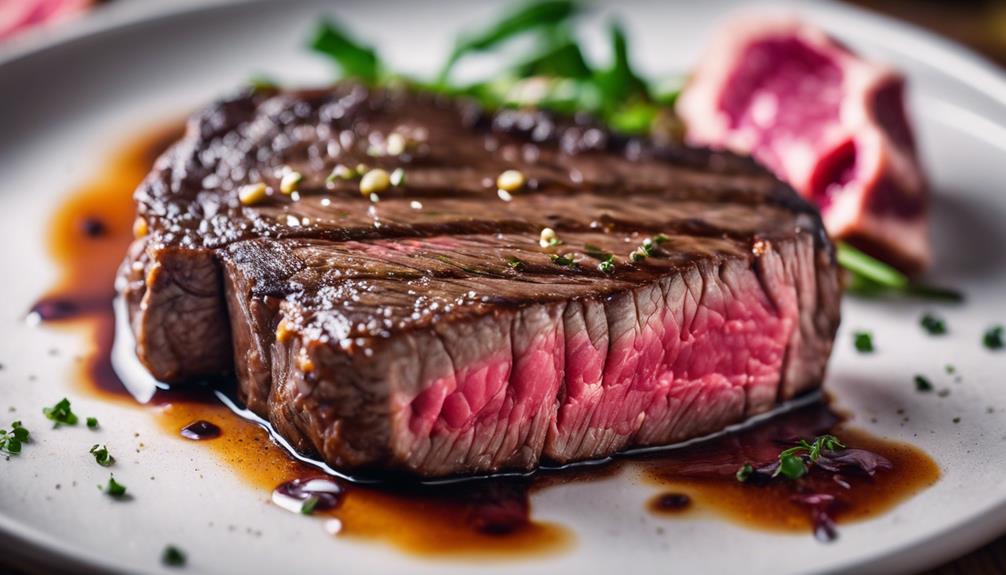
When selecting bison meat cuts for sous vide cooking, consider opting for ribeye, sirloin, chuck roast, or tri-tip for a flavorful and lean culinary experience.
- Ribeye: Offers a perfect balance of marbling and tenderness, resulting in a juicy and succulent sous vide steak.
- Sirloin: Known for its robust flavor and leaner profile, ideal for those seeking a healthier option without compromising taste.
- Chuck Roast: A versatile cut that becomes incredibly tender when cooked sous vide, making it perfect for shredding or slicing.
- Tri-Tip: With its rich flavor and moderate marbling, this cut cooks beautifully sous vide, ensuring a moist and tender outcome every time.
Bison meat's leanness pairs exceptionally well with the precise cooking method of sous vide, allowing you to achieve consistent results and retain the natural flavors of the meat. Opting for these bison cuts guarantees a culinary experience that's both satisfying and health-conscious.
Succulent Bison Ribeye Recipe
You're in for a treat with this succulent bison ribeye recipe guide. Pairing these steaks with a peppercorn sauce can take your culinary experience to the next level.
Don't forget to marinate your bison ribeye before sous vide cooking for a burst of flavor that will leave you craving more.
Sous Vide Bison Ribeye Guide
For an unforgettable dining experience, consider delving into the world of sous vide cooking with succulent bison ribeye steaks.
- Season your bison ribeye steaks with salt, pepper, olive oil, and herbs before sous vide cooking to enhance their natural flavors.
- Sous vide cooking guarantees precise temperatures for consistent and perfectly cooked bison ribeye steaks every time.
- After sous vide cooking, sear your bison ribeye steaks in a hot skillet to create a delicious crust while keeping the insides juicy.
- Customize the doneness of your bison ribeye steaks to your preference, whether you prefer them medium-rare or medium.
Sous vide cooking bison ribeye steaks offers a level of control and tenderness that's difficult to achieve through traditional cooking methods.
Peppercorn Sauce Pairing Suggestion
Curate a sensory symphony on your plate by drizzling your succulent bison ribeye steak with a velvety peppercorn sauce that harmonizes rich flavors with each tender bite.
The peppercorn sauce is a classic pairing for bison steaks, enhancing the overall dining experience.
Made by deglazing the pan with wine or brandy, it captures all the delicious browned bits for a rich flavor profile.
Ingredients like black peppercorns, shallots, beef broth, and cream create a creamy and indulgent finish.
The bold and peppery notes of the sauce perfectly complement the lean, slightly sweet flavor of bison meat, elevating the dish to a gourmet level.
Bison Ribeye Sous Vide Marinade
Enhancing the succulent bison ribeye experience begins with crafting a flavorful marinade that will elevate the natural richness of the meat when prepared using the sous vide method.
- Infuse Flavors: Marinating bison ribeye in a blend of herbs and spices allows the meat to absorb a depth of flavors.
- Tenderize Meat: The sous vide cooking method guarantees that the ribeye is cooked evenly, resulting in a perfectly tender steak.
- Enhance Juiciness: The marinade, combined with sous vide cooking, helps create a juicy and succulent bison ribeye.
- Maximize Flavor: Pairing the sous vide bison ribeye with a bone broth reduction adds a savory and rich element that maximizes the overall taste profile.
Crafting a delicious marinade and utilizing the sous vide method guarantees a mouthwatering bison ribeye steak that will impress any guest.
Searing for Bison Ribeye
When searing bison ribeye, the key lies in achieving a perfect caramelized crust.
The sizzle and aroma that fill the kitchen as the steak hits the hot skillet are tantalizing.
Searing enhances not just the flavor but also the visual appeal of your bison ribeye, making it a sensory delight.
Searing Techniques for Bison
For achieving a delectably seared finish on your bison ribeye steaks post sous vide cooking, employing a scorching hot cast iron skillet is vital to swiftly sear without risking overcooking. The cast iron's ability to retain high heat evenly makes it an ideal choice for achieving that perfect sear on your bison ribeye.
When searing bison ribeye, using oils with high smoke points like coconut or avocado oil can help you achieve a beautifully caramelized crust without burning the oil. Make sure your bison ribeye steaks are thoroughly dried before searing to prevent steaming and guarantee a crispy exterior.
Mastering the searing technique for bison ribeye enhances the overall taste and texture, elevating your dining experience.
Best Searing Temperatures
To achieve a perfect crust on your bison ribeye steaks, searing at temperatures between 400-450°F is crucial. Searing at medium high temperatures allows for the Maillard reaction to take place, enhancing the flavor profile of the steak. This range is ideal as it helps to develop a caramelized exterior while keeping the interior tender and juicy.
Searing at higher temperatures creates a nice crust without overcooking the meat, preserving its natural juices. Having a hot skillet or grill ready is vital to guarantee a quick and effective sear. By searing your bison ribeye steaks at these temperatures, you'll elevate the overall dining experience, creating a delectable dish that's sure to impress.
Searing Time Recommendations
Achieving a perfect crust on your bison ribeye steaks requires precise timing during the searing process. When searing bison ribeye steaks cooked sous vide, aim for around 1-2 minutes per side.
This essential searing time is vital to lock in the juices and flavors developed during the sous vide cooking. The quick sear in a hot skillet not only enhances the texture but also adds a delightful caramelized finish to the meat.
Final Thoughts
In considering the overall experience of preparing and savoring these sous vide bison steaks, one cannot help but appreciate the harmonious blend of tenderness, flavor, and culinary expertise that this dish embodies. The sous vide cooking method truly shines in this recipe, yielding steaks that are incredibly tender and juicy. The addition of the bone broth reduction elevates the flavor profile, offering a rich and savory experience that complements the natural taste of the bison.
| Final Thoughts | |
|---|---|
| Tenderness | Unparalleled |
| Flavor | Rich and savory |
| Culinary Expertise | Evident |
| Sous Vide Technique | Perfectly executed |
| Overall Experience | Exceptional |
Every bite of these sous vide bison steaks with bone broth reduction is a confirmation to the precision and care put into their preparation. The result is a gourmet dining experience that showcases the full potential of sous vide cooking techniques. Serve this dish to impress and delight your guests with its exquisite flavors and tender texture.
Frequently Asked Questions
How to Cook Bison Steaks Sous Vide?
To cook bison steaks sous vide, pre-sear them for flavor, then vacuum-seal and cook at 129°F for medium-rare perfection. Finish with a quick sear for a caramelized crust. Sous vide guarantees even doneness throughout the meat.
What Temperature Is Best for Bison Steak?
For bison steak, the optimal temperature control is at 130°F. This precision guarantees the meat retains its rich flavors and juices, leading to a tender, perfectly cooked steak. Achieve your desired doneness without any risk of overcooking.
How Much Does Bison Shrink When Cooked?
When cooking bison, shrinkage rates can vary but typically range from 25-30%. Factors like cooking method, temperature, and initial moisture content influence this. Bison's leanness compared to beef may result in less shrinkage.
Why Is My Bison Steak Tough?
Your bison steak might be tough due to its leanness. Try bison tenderizing techniques like sous vide cooking for precise temperature control. Slicing against the grain and using bone broth reduction can also enhance tenderness and flavor.
Conclusion
Indulge in the tender and rich flavors of sous vide bison steaks with bone broth reduction. The precision cooking method of sous vide guarantees a perfectly cooked steak every time, while the bone broth reduction adds depth and richness to each savory bite.
Searing the steak at the end gives it that perfect caramelized crust, completing the dish with a burst of flavor. Elevate your next meal with this succulent bison ribeye recipe and impress your guests with your culinary skills.
